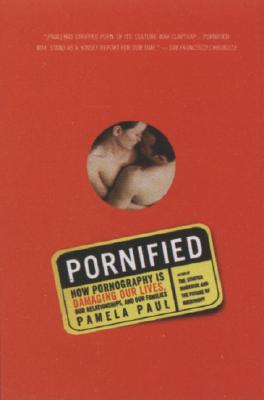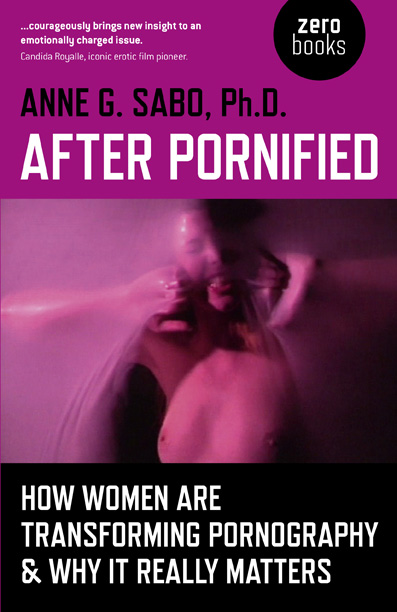Before I was in a steady relationship I had never watched porn, I never thought to. I had read lots about sex: teen fiction, novels, women’s magazines and online, but my only encounters with porn interfaces were gaudy and flashing side bars – big tit blondes with their legs spread, Asian fetish sites – whatever your ‘category’ type, these were screens from which to recoil. That it was my boyfriend who introduced me to the possibility of porn without shame is ironic, or at least mistimed – I could have done with the recourse far more before. But when we did feel like watching some together, it would have been good to have the recommendations of feminist writer and researcher Anne G. Sabo’s After Pornified to hand. Now I do.
After Pornified, How Women Are Transforming Pornography and Why it Really Matters (Zero, October 2012) is an instructive title, and references US journalist Pamela Paul’s Pornified: How Pornography Is Transforming Our Lives, Our Relationships, and Our Families (2005), which focused solely on negative aspects of society’s hypersexualisation. Sabo writes straightforwardly about directors who are revising the idea and the images of porn, to make explicit content more realistic, sexually democratic and inclusive of feminine points of view. Another recent Zero Books release, Levitate the Primate (a more dubious title) by Michael Thomsen, meanwhile openly talks about male sexual experience from a personal perspective. I’ll come to discuss Thomsen later: put in a room together, I’m not sure the two would get along.
Sabo charts a counter current in porn production: namely, to please girls. She summarises the work of feminist filmmakers who are creating porn or erotica that represents something other than brute cocks, Barbie-like nubiles, tan in-a-can torsos, or worse, soft-focus ‘X-Art’. Directors that present relatable characters; that objectify the male body in equal dose to the female. The women directors she discusses include Swedish born, Barcelona-residing Erika Lust, who founded Lust Films as an alternative to mainstream porn, to focus on female fantasy and sexual liberation; Swedish outsider filmmaker Mia Engberg, who commissioned twelve artists to make their fifteen minute take on feminist porn with their cell phones in Dirty Diaries; London-based Anna Span, whose Hoxton Honey follows hip girls running around town in pursuit of their desires; and Ovidie, who at 18 saw in porn the potential to transgress and revolt, and who now, a mother, has conceived the French sex education and erotica channel, frenchlover.tv. “Departing from the idea that it would be suicidal to leave pornography solely in the hands of men, she set herself the goal of creating her own films, which would display feminine sexuality in a realistic and respectful way”, reads Ovidie’s bio. These female directors are amongst many others in the US, Australia and Europe – and I wonder if there are also examples to be found in Asia.
Sabo traces the origins of the “women’s progressive porn movement” back to Candida Royalle’s radical work in the seventies. Royalle founded Femme Productions to make what she called a “couples erotica” that was “sensually explicit”. She also formed Club 90 as an outlet to discuss sexuality with former porn actresses, striving to, as Sabo puts it:
Sabo uses the early precedent set by Royalle to form criteria against which to measure the quality of the new generation of feminist filmmakers. These criteria are split between the categories of “high cinematic production value” and “progressive sexual-political comment”. Often, I’d rather read a more rigorous consideration of the latter – the questions which arise from the subversion of or adherence to sexual politics on camera – rather than Sabo’s lengthy visual analyses of the films, which confirm little more than that the lighting complements the atmosphere. We can, after all, go watch the films ourselves – as she urges us.

But if Sabo’s analyses are sometimes superficial, she lays out a useful collection of what the genre consists in, and how it came into being. These are figures who are for many still hidden beneath the bedsheets: consider buying this book, girls and boys both, if only for the Appendix of titles. Importantly, she exposes that there is demand, citing statistics that suggest women make up around one third of all porn viewers, while another study suggests that though women did report being physiologically aroused by hardcore porn, psychologically, they felt conflicted. Erika Lust explains this ambivalence in an interview with VICE: “There was a huge discrepancy between what I physically felt, and what I emotionally and intellectually felt.” One can imagine that if more women were made aware of femme porn, the viewing stats might equal out. (1)
Sabo rightly problematises the very label of ‘porn for women’. For some directors, the naming of their work is contentious, with the negative connotations attributed to ‘porn’, and the overly softcore associations of ‘erotica’. Making porn for women came out of the fact that the unspoken standard was porn by and for men, but now of course, men might enjoy such alternatives to mainstream films too. Further, the idea of a ‘porn for women’ may seem simplistic: contrary to the coiners of the ‘mummy porn’ label for the supposedly transgressive tales of E L James and co., women do not all want one thing (nor do men); such are our diverse libidos, our desires which ebb, change course, and flow.
The question of whether any porn can be feminist is likely to divide: how far should we politicise desire? Porn for and by women is then about asserting the fact that women may and do enjoy watching sex on screen. It’s about undoing violent visual tropes of acts abusive towards women, as well as the opposite stereotype that presumes women prefer their erotica soft-round-the-edges – ‘loving’ or with a pretence of sincerity. It’s about presenting the possibility of “non-goal based erotica”, which sounds something like the filmic equivalent of écriture feminine – finding new visual languages, not ending with an argued climax, not finishing with the ubiquitous money shot. It’s about overcoming unspoken shame barriers that suggest that we are less aroused by visual stimulus, or further, that our sex drives do not extend as far in fantasy or reality as the male who wants to ‘spread his seed’. (2)
Which brings me to New York writer, Michael Thomsen’s Levitate the Primate, subtitled Handjobs, Internet Dating, And Other Issues for Men. Thomsen describes the aforementioned cum shot as “the visual punctuation for the vicarious masturbator”, in a chapter, ‘Come on my face’. Here he describes his unease with classic porn tropes, or rather, his unease with his experience that it is these hardcore tropes that best turn him on:
“All the Vaseline-lit softcore porn feels unnatural and alien. The athletic grinding and animalistic hammer sessions seem to be the most honest to me.”
Porn is still porn, and this means being aroused by bodies, extremities, fluids. On the whole, Thomsen writes about porn only in passing, in fact claiming that nowadays, he prefers to masturbate without visual stimulation. It was the author’s blog piece, ‘Ordering the Aspirations Inside Our Underpants’ that drew me to the collection with the line: “Sex is an impossible subject then, because there is nothing privileged about it.” With the admission that writing about sex is like dancing around architecture, (enjoyable, I think you’ll agree) Thomsen takes up the task, talking openly about his attitudes and anxieties towards sex and its relational paraphernalia, grounded in the viewpoint of a thirty-something heterosexual male.

As a genre, you could say that male-written tales of sex now appear less than female-penned ones, despite the fact that male depictions of sexuality have overwhelmed literature past. There’s the assumption that guys talk less about sex with their friends than girls, and while series like Sex and The City and Lena Dunham’s Girls – for all their liberations or limitations – celebrate the femme experience of urban relationships, it’s hard to think of a current male equivalent – at least not a confessional one. But guys have their porn channels, right? (3)
At times Thomsen’s episodes, told in the short space of his past columns for the website Nerve do read like a Brooklyn boy’s version of Girls – the unsavoury sexual encounters of a man about town, full of awkward moments, failed orgasm and honest flab. Some people coyly read Fifty Shades on the tube, but try reading books with chapters headed ‘Shave my Bush’, ‘My First Muff Dive’ and ‘Rate My Blowjobs’, in a busy commuter carriage. The pieces originated, Thomsen writes in the introduction, “as an attempt to make conversational pot pourri about sex to ensnare the idle eyes of office workers in search of relief from spreadsheets”. (Note, Zero, it’s therefore hard to qualify these pieces as ‘Social Science’). His subjects mostly emerge from the question: “Am I doing this right?”
Levitate the Primate is characterised by both the best and the worst thing about Zero publications: the transition from blog posts to books, which often provides timely content and current political ideas, but which also has a tendency to read like a slapdash amalgamation of halfway thoughts. Thomsen realises the fragmentary nature of this output, but Barthes’ A Lover’s Discourse – a prime scattering of love into little pieces – his book is not. The reality of the collection veers from pertinent social insight to anecdotal hilarity and mundane encounter. I agree and disagree with his observations at turns, am equally bored and entertained. However, occasionally Thomsen is so flippant with language, or so honest with his thoughts, that he offends – in the case of the use of “mucus flaps” to describe a vagina, irredeemably so. I do not, in general, want anyone that refers to female genitalia as such on my bookshelves. I think, more than once: “I hope the people he’s slept with have a sense of humour.”
If I still have some time for the collection then, it’s for Thomsen’s voicing of issues around performance and masculinity, social expectation and vulnerability, with a rare candidness. These are the raw neuroses of sex: premature ejaculation, body image, STDs; and the coming to terms with them: finding satisfying masturbation positions, knowing what you want from a date, considering penis anxiety just another symptom of steroidal porn.
Both writers succeed in an honest discussion of sex, refusing to let their writing around such topics be repressed – though in both cases this discussion comes from a predominantly heterosexual point of view. The female directors that are the subject of Sabo’s work at their best subvert the tropes of mainstream porn and play with the pleasures of seeing. They also help to surpass mainstream conservative stereotypes around what women desire, beyond the likes of the erotic fiction boom, showing that objects of lust need not be millionaire businessmen, that fantasies contain more than master-maid S & M. What Sabo and Thomsen’s reflections positively put forward is that there is no one formula to make all women wet, or men hard. And this is a thing of jouissance in itself.
After Pornified and Levitate The Primate are out now, published by Zero Books
- The writing of this piece coincides with the launch of a new French site of porn for and by women, www.dorcelle.com – just as, incidentally, the head of YouPorn is arrested in Brussels.
- For an interesting discussion of these questions listen to Carrie Plitts’ podcast on NTS
- In a similar vein, but with more fictional bent, I recommend Crispin Best’s ‘Everyone I’ve Never Had Sex With’
- Thomsen has since written a piece on Hazlitt, ‘Great Writers Make Lousy Lovers’; his essays for The New Inquiry and others are subtler, and I think better, than those in Levitate The Primate
Follow @theQuietusBooks on Twitter for more


